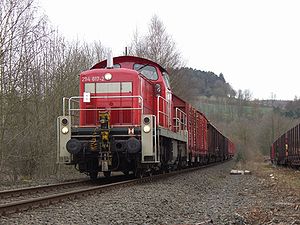Niederaula – Alsfeld railway line
| Niederaula – Alsfeld | |||||||||||||||||||||||||||||||||||||||||||||||||||||||||||||||||||||||||||||||||||||||||||||||||||||
|---|---|---|---|---|---|---|---|---|---|---|---|---|---|---|---|---|---|---|---|---|---|---|---|---|---|---|---|---|---|---|---|---|---|---|---|---|---|---|---|---|---|---|---|---|---|---|---|---|---|---|---|---|---|---|---|---|---|---|---|---|---|---|---|---|---|---|---|---|---|---|---|---|---|---|---|---|---|---|---|---|---|---|---|---|---|---|---|---|---|---|---|---|---|---|---|---|---|---|---|---|---|
|
Freight train on the Gründchenbahn
| |||||||||||||||||||||||||||||||||||||||||||||||||||||||||||||||||||||||||||||||||||||||||||||||||||||
| Route number (DB) : | 3811 | ||||||||||||||||||||||||||||||||||||||||||||||||||||||||||||||||||||||||||||||||||||||||||||||||||||
| Course book section (DB) : | last 516 (1974) | ||||||||||||||||||||||||||||||||||||||||||||||||||||||||||||||||||||||||||||||||||||||||||||||||||||
| Route length: | 34.4 km | ||||||||||||||||||||||||||||||||||||||||||||||||||||||||||||||||||||||||||||||||||||||||||||||||||||
| Gauge : | 1435 mm ( standard gauge ) | ||||||||||||||||||||||||||||||||||||||||||||||||||||||||||||||||||||||||||||||||||||||||||||||||||||
|
|||||||||||||||||||||||||||||||||||||||||||||||||||||||||||||||||||||||||||||||||||||||||||||||||||||
The Niederaula – Alsfeld railway line , also known as the Gründchenbahn , was a railway line from Niederaula via Grebenau to Alsfeld , where it met the Vogelsberg Railway in the direction of Giessen .
course
The Gründchenbahn is a 31.3 kilometer stretch from Alsfeld on the Vogelsbergbahn to Niederaula, where it joins the Knüllwaldbahn . In Niederaula-Niederjossa the line to Bad Salzschlirf branched off.
history
The railway line was opened in three sections: Niederaula – Niederjossa on November 10, 1914, Niederjossa – Grebenau on April 1, 1915 and Grebenau – Alsfeld on April 1, 1916. Passenger traffic was discontinued on May 25, 1974, as was freight traffic between Eifa and Black. Freight traffic between Grebenau and Schwarz ended in 1979. Between Alsfeld and Eifa, goods traffic continued until September 28, 1984, and between Grebenau and Breitenbach (Herzberg) it ended on October 1, 1994.
The remainder of the route from Niederaula to Breitenbach will continue to be operated by freight. The route between Alsfeld and Eifa is still partially preserved. From Eifa, a good 100 meters north of the “Im Grund” corridor and just under 200 meters west of the “Bürgermeister-Wagner-Straße”, to Breitenbach am Herzberg, the route has been dismantled. There the railway line ends almost 100 meters south-southwest of the "Steinmühle" property. The buffer stop from Niederaula is located at the timber loading point.
workload
Until the 1950s, the railway line was very well used for both freight and passenger traffic. So-called "multiple unit express trains" of the first and second class ran from Alsfeld via Bad Hersfeld to Kassel and continuous passenger trains from Bad Hersfeld via Alsfeld to Gießen - daily.
With the beginning of the auto boom, demand dropped noticeably, so that for reasons of rationalization, the steam locomotives were increasingly being replaced by rail buses . The first indications of a line closure came from an article in the Oberhessische Zeitung published in Alsfeld on January 14, 1966, the headline of which was: "Railway to Hersfeld still?"
Viaducts between Alsfeld and Grebenau
The topographical location in the last completed section Alsfeld to Grebenau was characterized in the transition from the Alsfeld basin to the Grebenauer Grund by deeply cut valleys, mountain ridges and special geological conditions. On the one hand, this required the construction of high earth walls, on the other hand, viaducts had to be built:
The viaduct at Eifa is 230 meters long and 30 meters high. It is registered as an architectural monument. A second viaduct at the Hardtmühle was demolished in 1992. It was 213 meters long and 24 meters high.
Both arch bridges were constructed as non-reinforced concrete structures. Brick powder was added to the concrete mass , which led to the desired hydraulic properties. Due to the vault principle , the forces of the bridge were diverted like in medieval church vaults . At the time of its creation, this type of construction was no longer up-to-date, as reinforced concrete had been a common building material since 1860. The reason for this type of construction may be to be found in the fact that Germany was in the First World War during the construction phase and steel, which was reserved for armaments, was substituted for bridge constructions by using the old vault principle, which withstood both pressure and tension.
See also
literature
- Matthias Nicolai: After 63 years it was over again . In: Lauterbacher Anzeiger, April 2, 2016, p. 23.


